Agency professionals face constant pressure to deliver results. Facebook Ads remain a valuable tool, but the platform keeps changing. Clients want more for their money, and keeping up with Facebook’s whims is a full-time job..
Success in Facebook Ads now goes beyond reach or creative ideas. It’s about understanding which numbers count and in what order. Speaking data fluently means turning figures into stories that resonate with clients and drive real business outcomes.
This guide is for agency team members who’re ready to improve their Facebook Ads skills.
Together, we’ll examine the metrics and tactics that actually work. You’ll finish with a solid grasp of which numbers really matter, how to prioritize them, and how to use them to set your agency apart.
10 Most Importan Facebook Ads Metrics to Track
Why It’s Important: Tracks the revenue generated for every dollar spent on ads.
What Does It Measure: Financial return on ad investment.
How to Calculate: ROAS = Revenue / Ad Spend.
Benchmark: Industry-dependent. E-commerce campaigns aim for 4:1 or higher, while service-based industries may find 2:1 sufficient.
Best For: Evaluating overall campaign profitability.
Related Metrics: CPA, AOV.
Common Pitfalls: Doesn’t consider customer lifetime value or delayed conversions.
Why It’s Important: Measures the cost of achieving a specific action, such as a sale or lead.
What Does It Measure: Efficiency of converting prospects into customers.
How to Calculate: CPA = Total Spend / Number of Conversions.
Benchmark: Varies by industry. For e-commerce, a CPA under $30 is often ideal.
Best For: Optimizing budget allocation and improving cost efficiency.
Related Metrics: ROAS, Conversion Rate.
Common Pitfalls: Low CPA can still lead to unprofitable campaigns if conversions don’t generate sufficient revenue.
Why It’s Important: Indicates how effectively ad traffic leads to conversions.
What Does It Measure: The percentage of users who take a desired action after clicking the ad.
How to Calculate: Conversion Rate = (Conversions / Total Clicks) × 100.
Benchmark: Typically 2-5% for e-commerce campaigns; can vary widely by industry.
Best For: Assessing ad targeting and landing page effectiveness.
Related Metrics: CTR, CPA.
Common Pitfalls: A high conversion rate doesn’t always mean profitability if ROAS or AOV are low.
Why It’s Important: Tracks how much you pay for each click on your ad.
What Does It Measure: The cost of driving traffic to your website or landing page.
How to Calculate: CPC = Total Spend / Total Clicks.
Benchmark: Generally ranges from $0.50 to $3.50 depending on the industry.
Best For: Balancing ad spend with traffic generation.
Related Metrics: CTR, ROAS.
Common Pitfalls: A low CPC doesn’t always equate to quality traffic or conversions.
Why It’s Important: Indicates the percentage of users who clicked your ad after seeing it.
What Does It Measure: Ad engagement and appeal.
How to Calculate: CTR = (Clicks / Impressions) × 100.
Benchmark: A CTR of 1-2% is common for Facebook Ads.
Best For: Assessing creative effectiveness and targeting accuracy.
Related Metrics: CPC, Conversion Rate.
Common Pitfalls: High CTR with low conversion rate might indicate a mismatch between ad messaging and landing page content.
Why It’s Important: Tracks how many times, on average, a user sees your ad.
What Does It Measure: Ad exposure to individual users.
How to Calculate: Frequency = Impressions / Reach.
Benchmark: Ideal range is 1-3 for most campaigns; higher frequencies may lead to ad fatigue.
Best For: Managing audience engagement and preventing saturation.
Related Metrics: Reach, Impressions.
Common Pitfalls: High frequency without conversions may indicate ad fatigue or poor targeting.
Why It’s Important: Impressions show total ad views; reach indicates unique users.
What Does It Measure: Ad visibility and audience coverage.
How to Calculate: Reach is calculated by Facebook based on unique user views; impressions are the total number of views.
Benchmark: Benchmarks depend on campaign objectives; compare to audience size for context.
Best For: Assessing brand awareness campaigns.
Related Metrics: Frequency, CTR.
Common Pitfalls: High impressions without reach growth may indicate limited audience targeting.
Why It’s Important: Indicates interest in your product and intent to purchase.
What Does It Measure: The percentage of users who add items to their cart after clicking the ad.
How to Calculate: Add-to-Cart Rate = (Add-to-Cart Actions / Total Clicks) × 100.
Benchmark: 5-8% for e-commerce campaigns; higher rates indicate strong product interest.
Best For: Measuring mid-funnel performance.
Related Metrics: Conversion Rate, Purchase Rate.
Common Pitfalls: High Add-to-Cart Rate with low purchase rate may indicate checkout issues.
Why It’s Important: Tracks how much of your video users watch.
What Does It Measure: Engagement with video content.
How to Calculate: Completion Rate = (ThruPlays / Video Impressions) × 100.
Benchmark: Completion rates above 50% are strong; aim for 70%+ on shorter videos.
Best For: Evaluating video ad effectiveness.
Related Metrics: CTR, Engagement Rate.
Common Pitfalls: Low completion rates often result from weak hooks or irrelevant content.
Why It’s Important: Indicates the average value of transactions driven by your ads.
What Does It Measure: The quality of conversions, not just quantity.
How to Calculate: AOV = Total Revenue / Number of Orders.
Benchmark: Dependent on industry. Higher AOV generally indicates profitable customers.
Best For: Evaluating e-commerce performance.
Related Metrics: ROAS, CPA.
Common Pitfalls: High AOV with low purchase volume may indicate overly niche targeting.
The Strategic Value of Understanding Metrics
Before we discuss specific metrics, let’s consider why this matters so much for our agencies. Facebook Ads metrics do more than just show campaign performance. They’re our connection to client satisfaction and the key to improving campaigns.
Client Satisfaction
We’ve all been down this road: you’re meeting with a client, explaining the value of their Facebook Ads investment. A spreadsheet full of numbers won’t suffice.
They want tangible results – more sales, more leads, or increased brand recognition. The right metrics, presented effectively, prove our value clearly.
Clearly communicated metrics change a client’s view of us from an expense to an essential part of their growth strategy.
Campaign Improvement
For agencies, the metrics discussed below guide every decision. They inform choices about targeting, creative, and budget allocation. Tracking and analyzing the right data points allows continuous improvement of performance. This approach gives us the confidence to make bold moves supported by solid information.
We reached out to a Facebook/Meta specialist, and in our interview with social media advertising expert Akvile DeFazio, President of AKvertise, she emphasized this comprehensive approach to metrics:
Even if you are running an upper-funnel campaign, such as an engagement campaign, you may still want to look at some of these key performance metrics in case any conversions come through.
This insight reminds us that success requires monitoring both primary and secondary metrics across all campaign types.
A thorough understanding of these metrics and their relative importance prevents us from working blindly. It allows us to track performance effectively, justify ad spend to clients, and stay ahead of the competition.
Focusing on the right numbers in the right order provides actionable insights that demonstrate value and guide future strategy.
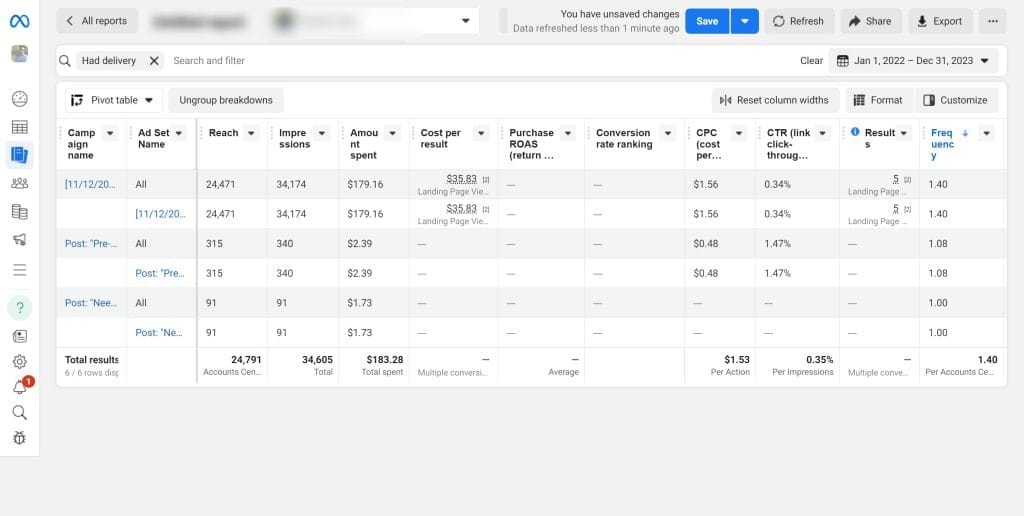
Now, let’s look at the metrics that truly matter for our agencies and clients. We’ll break these down in order of importance, focusing on results-driven metrics that reflect profitability and client satisfaction, followed by performance improvement metrics that help refine campaigns.
If you don’t track the right metrics, you won’t know why users drop off, what’s working (or not), or how to improve.
This underscores the importance of tracking both primary and secondary metrics across all campaign types.
1. ROAS (Return on Ad Spend) – The Profit Indicator
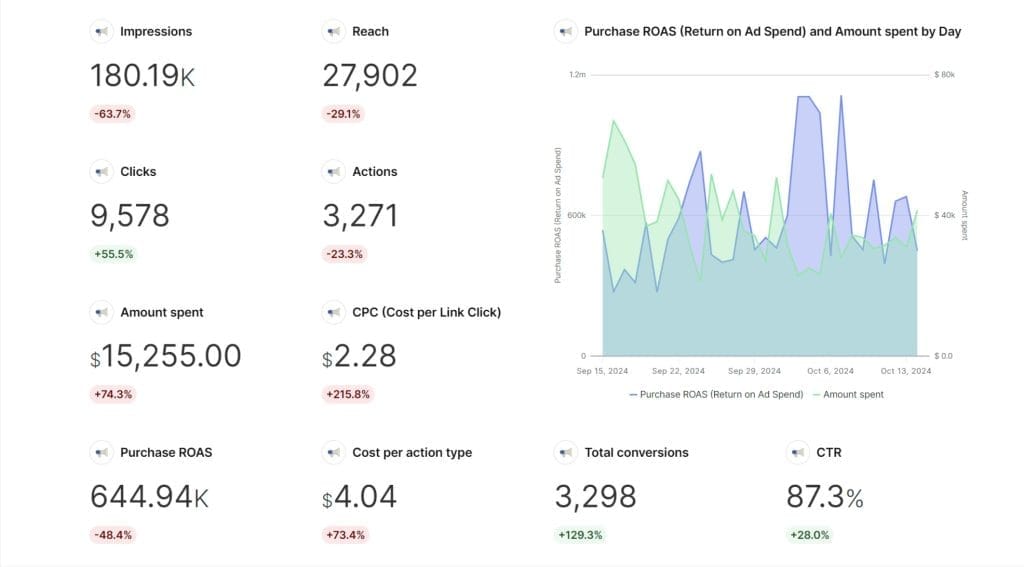
ROAS is the heavyweight champion of Facebook Ads metrics. It measures the revenue generated for every dollar spent on ads. For example, a $1,000 campaign earning $5,000 in revenue shows a ROAS of 5:1.
Why ROAS Is Top Priority
ROAS answers the crucial question every client asks: “Is this making me money?” It directly shows the financial return clients get from their ad investment. In an era of constant pressure on agencies to prove their worth, a strong ROAS serves as our best defense. Simply put, if ROAS looks bad, other campaign aspects lose significance.
How to Use ROAS Effectively
- Set ROAS goals with clients based on their industry and business model
- Use ROAS to guide budget allocation, focusing resources on top-performing campaigns
- Compare ROAS across different products, services, or audience types to inform broader marketing strategies
Handling ROAS Fluctuations
ROAS changes based on various factors. Here’s a breakdown of what affects ROAS and how to address it:
| Factor | ROAS Impact | How to Address |
|---|---|---|
| Seasonal Trends | Causes ups and downs | Plan for busy and slow seasons, adjust budgets accordingly |
| Increased Competition | Can lower ROAS | Refine targeting, improve ads to stand out |
| Consumer Behavior Shifts | Affects conversion rates | Stay flexible, ready to change strategies |
| Platform Updates | Impacts ad delivery and efficiency | Stay informed of Facebook changes, prepare to adapt |
Analyze ROAS trends over time rather than fixating on short-term changes. This long-term view enables smart decisions that maintain campaign profitability for clients over time.
ROAS Throughout Campaign Lifecycle
Understanding ROAS changes throughout a campaign helps set realistic client expectations and prompts timely improvements:
- Early Stage (Week 1-2): ROAS might start lower as Facebook’s system learns and adjusts. Focus on other early indicators like CTR to gauge initial performance.
- Growth Phase (Week 3-4): ROAS should start improving. Reassess targeting, ad creative, or offers if no improvement shows by week 4.
- Stable Phase (Week 5+): ROAS should stabilize at a profitable level. Maintain performance and watch for ad fatigue signs.
Discussing ROAS with Clients
Context is key when talking about ROAS with clients. Always compare it to:
- Industry benchmarks
- Performance of other marketing channels
- Historical performance
A “good” ROAS varies widely depending on industry, profit margins, and long-term customer value. A 2:1 ROAS can be highly effective for businesses with a high customer lifetime value, as they may rely on repeat purchases or upselling to turn a profit over time. However, for a low-margin online store, a 2:1 ROAS might not be sufficient to cover operating costs and generate profit, as the slim margins leave little room for advertising expenses.
Always track ROAS alongside spend to get a complete picture of your campaign’s financial performance.
Pro Tip: Explain to clients how ROAS varies for different campaign objectives. Brand awareness campaigns might not show high immediate ROAS but build future value. Setting appropriate expectations positions you as a strategic advisor, not just an ad manager.
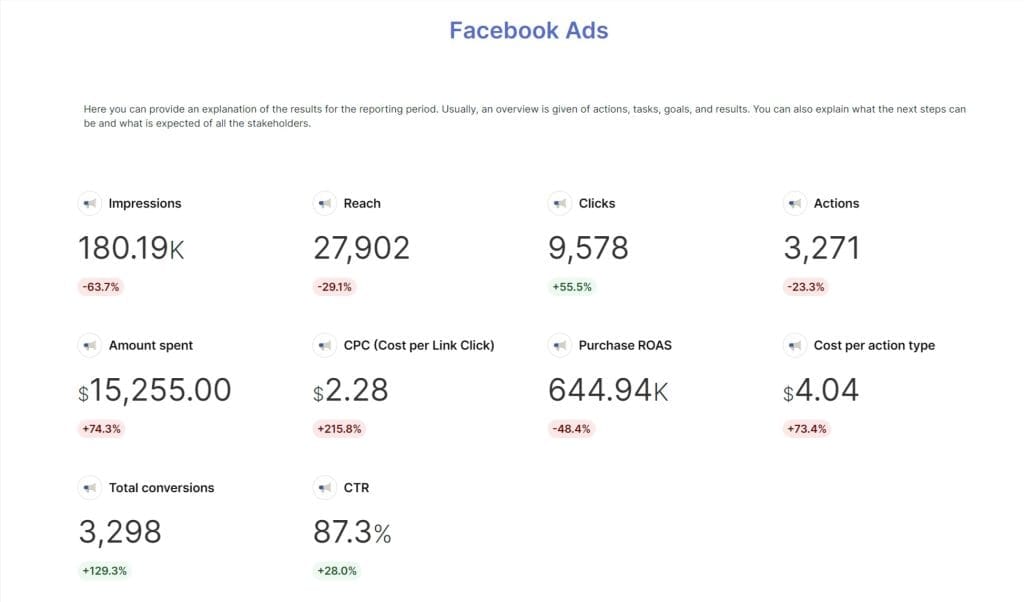
2. CPA (Cost Per Action/Conversion) – The Efficiency Measure
CPA shows the average cost to achieve a specific action or conversion. It’s all about efficiency – how much do you spend to get each valuable customer action?
Why It’s Second to ROAS
CPA follows right behind ROAS on our priority list. It demonstrates how cost-effectively our campaigns achieve client goals, whether that’s sales, signups, or other objectives. Clients expect low CPA without sacrificing results – a tricky balance that showcases our expertise.
How to Improve Campaigns with CPA
- Set CPA targets aligned with client goals and industry norms
- Compare CPA across different ad sets, audiences, or creative approaches to identify winners
- Reduce CPA over time, showing clients we’re maximizing their budget
CPA Strategies
Agency veterans know CPA isn’t just about the lowest number. Find the sweet spot where valuable customers come in efficiently. Here’s how to handle CPA complexities:
- Determine True Action Value: Work with clients to calculate the real worth of each conversion. Higher CPA might make sense for high-value, long-term customers. Akvile DeFazio illustrates this with lead generation campaigns:
While Facebook’s native lead forms typically generate leads at a lower CPA, website traffic campaigns directing users to landing page forms often yield higher-quality leads. These campaigns tend to get fewer leads and at a slightly higher cost, however, the lead quality is greater since these users are interested enough to leave Facebook to learn more.
- Consider the Full Journey: A higher CPA early in the customer journey could lead to more efficient conversions later. Think beyond immediate conversions to the entire customer path.
- Spot Warning Signs: Rising CPA might indicate:
- Ad fatigue in your audience
- Outdated creative
- Increased competition for your target audience
- Use Smart Tools: Try Facebook’s Campaign Budget Optimization (CBO) to automatically distribute budget across ad sets for optimal cost per result.
Agency veterans know CPA isn’t just about the lowest number. Find the sweet spot where valuable customers come in efficiently. Here’s how to handle CPA complexities:exities:
CPA Changes Over Time
Understand typical CPA changes to set realistic expectations and make timely improvements:
| Campaign Stage | CPA Behavior | Action Plan |
|---|---|---|
| First Week | Higher CPA during learning phase | Monitor closely, avoid major changes |
| Second Week | Should start decreasing | Make minor adjustments if no improvement shows |
| Weeks 3-8 | Settles at efficient level | Apply data-driven improvements |
| Week 9+ | Might gradually increase | Refresh ads, explore new audiences |
Pro Tip: Re-evaluate Facebook Ads campaign setup, targeting, and ad creative if CPA doesn’t improve after the first week. For long-running campaigns, gradual CPA increases often occur as audiences grow familiar with ads, while sudden jumps down need immediate attention.
3. Conversion Rate – Turning Interest into Action
Conversion rate shows the percentage of people who take desired actions after interacting with your ad. It connects interest to action.
Why It’s Important for Agency Success
After ensuring profitability (ROAS) and cost-efficiency (CPA), conversion rate becomes the focus. It reveals if our traffic actually delivers value. Agencies prove their worth by improving this number, demonstrating skill in aligning ads with landing pages and finding the right audience.
Ways to Increase Conversion Rates
- Message Match: Align ad promises perfectly with landing page delivery
- Smart Retargeting: Re-engage interested users who didn’t convert initially
- Social Proof: Show testimonials, reviews, and case studies to build trust
- Create Urgency: Use limited-time offers or low-stock alerts (ethically) to prompt action
- Ongoing Testing: Try different ad designs, landing page layouts, and offers to find what works best
Understanding Conversion Rate Variations
Conversion rates change dramatically based on multiple factors. Key considerations:
| Factor | Conversion Rate Impact | Adaptation Strategy |
|---|---|---|
| Campaign Goal | Newsletter signups typically convert higher than purchases | Set realistic benchmarks for each objective |
| Brand Familiarity | New audiences usually convert lower than warm leads | Tailor messaging to audience familiarity level |
| Industry Norms | Conversion rates differ widely across sectors | Use industry averages as starting points, aim to surpass them |
| Device Type | Mobile often shows lower purchase conversion rates | Improve mobile experience, consider device-specific campaigns |
Pro Tip: Track smaller actions along the conversion path to improve conversion rates across the entire funnel. Monitor add-to-cart rates for e-commerce or form start rates for lead generation.
How Conversion Rate Relates to Other Metrics
Understanding how conversion rate interacts with other metrics uncovers valuable insights:
- High Click-Through Rate, Low Conversion Rate: Your ad grabs attention, but the landing page falls short (i.e. does not deliver on the promise made in your ad). Examine your landing page for relevance and user experience issues.
- Low Click-Through Rate, High Conversion Rate: Your targeting might be too narrow. Look for opportunities to expand your audience while maintaining quality.
- High Conversion Rate, Low ROAS: You convert well but possibly at too high a cost. Review your bidding strategy and audience targeting.
Analyzing these metric relationships pinpoints exactly where to focus improvement efforts in your funnel.
Diving deeper into the conversion funnel, pay attention to these crucial metrics:
Landing Page View Rate: This shows the percentage of users who not only click your ad but also allow the landing page to load fully. A high rate indicates quality traffic, while a low rate might suggest landing page issues or a mismatch between ad promise and landing page content.
Add-to-Cart/Click Ratio (ATC/Click): This metric reveals how often users who click your ad go on to add items to their cart. It provides insight into the effectiveness of your landing page and product offerings.
Purchase Rate: This shows the percentage of users who complete a purchase after clicking on your ad. It directly ties ad performance to actual sales.
4. CPC (Cost Per Click) – Getting Traffic at the Right Price
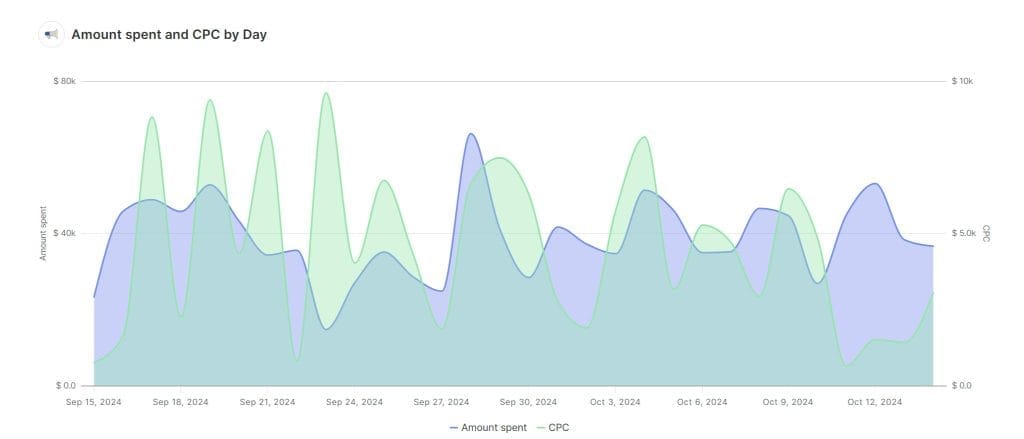
CPC reveals how much you pay for each ad click. Calculate it by dividing total campaign cost by the number of clicks received.
Why It Matters in Our Metric Priorities
Once conversion-focused metrics align, CPC becomes crucial for spend management. It helps understand if we’re overpaying for traffic, but remember – traffic quality (measured by conversion rate) matters just as much.
CPC Improvement Tactics
- Monitor CPC trends over time to identify potential issues or opportunities
- Use CPC data to refine bidding strategies and audience targeting
- Balance CPC with conversion metrics to ensure valuable clicks, not just cheap ones
Quality vs. Quantity in CPC
Experienced agency pros know a low CPC isn’t always the goal. Handle CPC complexities with these insights:
- Understand Click Value: Sometimes, higher CPC leads to better-quality traffic and ultimately lower cost per acquisition. Use real campaign data to illustrate this to clients.
- Consider Audience Factors: CPC varies based on:
- Demographic targets
- Interest categories
- User behaviors
- Time of day/week
- Device types
- Watch for CPC Increases: Sudden rises might indicate:
- Increased competition for your audience
- Decreased ad relevance
- Seasonal trends affecting your industry
- Advanced Strategies:
- Use dayparting to adjust bids during high-performing times
- Use audience insights to find less competitive, high-value segments
- Change ad creative regularly to maintain relevance and engagement
CPC Across Different Campaign Types
Understand how CPC fits different campaign goals to set appropriate expectations and strategies:
| Campaign Type | CPC Considerations | Strategic Approach |
|---|---|---|
| Brand Awareness | Typically lower CPC, focus on reach | Prioritize broad targeting, create engaging content |
| Lead Generation | Moderate CPC, balance with lead quality | Use lead scoring to assess true CPC value |
| E-commerce Sales | Can see higher CPC, focus on ROAS | Use dynamic product ads, optimize for purchase value |
| B2B | Often higher CPC due to niche targeting | Focus on high-quality content, use account-based marketing tactics |
Agencies must understand these nuances for clients, always keeping the big picture in mind. Higher CPC might be worthwhile if it brings in high-quality leads or customers with greater lifetime value.
Track it alongside ROAS, CPA, and CPM (Cost Per Mille/Thousand) to get a comprehensive view of your campaign’s efficiency.
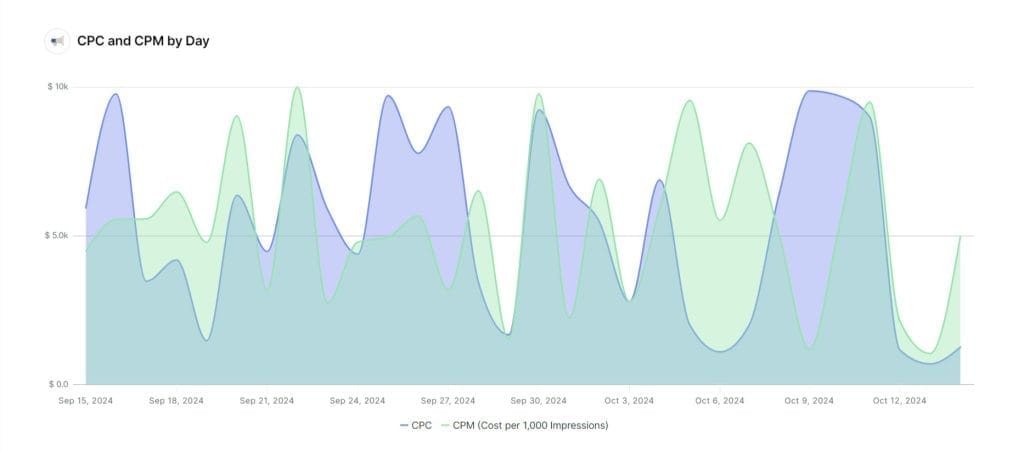
5. CTR (Click-Through Rate) – Measuring Ad Appeal
CTR shows the percentage of people clicking your ad after seeing it. This metric indicates how well your ads catch attention and prompt action.
CTR’s Role in Our Metric Priorities
CTR offers useful insights into ad engagement but ranks lower in priority than ROAS or CPA. Clicks don’t always lead to conversions. However, CTR is vital for assessing creative resonance with your audience and can significantly influence ad relevance scores and overall campaign effectiveness.
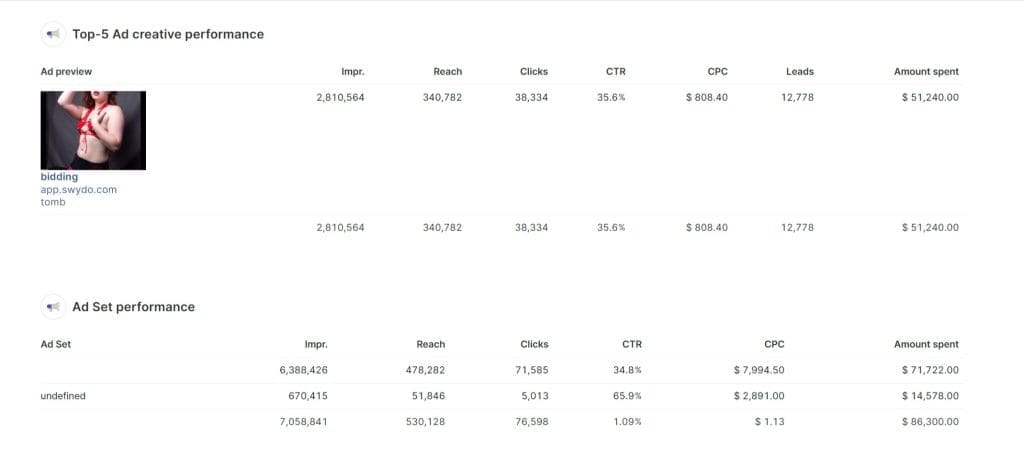
How to Use CTR to Enhance Campaigns
- Examine CTRs across various ad formats, placements, and audience segments
- Setup A/B testing of ad copy, visuals, and calls-to-action using CTR data
- Track CTR trends to spot potential ad fatigue or audience saturation
CTR Insights
Agency veterans understand CTR isn’t just about achieving the highest number. Consider these key factors:
- Placement Differences:
- News Feed ads typically outperform right-column ads in CTR
- Instagram Story ads often show different CTR patterns compared to in-feed ads
- Industry Context is Crucial: A “good” CTR in one sector might be average in another. Always view CTR within your client’s specific industry context.
- CTR and Ad Relevance Link: Higher CTR often results in better relevance scores, potentially lowering CPC and improving ad delivery. This creates a positive cycle, boosting overall campaign performance.
- Mobile vs. Desktop Differences: CTRs frequently vary between devices. Tailor ads for mobile viewing and engagement.
Addressing CTR Issues
Handle common CTR scenarios with this quick guide:
| Scenario | Possible Causes | Action Plan |
|---|---|---|
| High CTR, Low Conversion Rate | Misleading ad copy or misaligned landing page | Check ad-to-landing page consistency |
| Low CTR, High Conversion Rate | Overly narrow targeting or highly specific offer | Think about broadening audience or highlighting offer more clearly in ad |
| Declining CTR Over Time | Ad fatigue or audience saturation | Update creative, expand targeting, or try new ad formats |
| Inconsistent CTR Across Placements | Ad not suited for all placements | Create specific ads for each placement or use dynamic formats |
Pro Tip: Break down CTR analysis by device type, age group, and other demographic factors. Find audience segments that respond exceptionally well to your ads, informing future targeting and creative decisions.
For video ads, pay special attention to these metrics:
Thumb-stop Rate: This measures how often users pause their scrolling to watch your video ad. It indicates the initial appeal of your video content.
Hold Rate: This shows the percentage of your video that users watch on average. Higher hold rates suggest more engaging content.
6. Frequency – Balancing Ad Exposure
Frequency indicates how often, on average, individuals see your ad. This metric is crucial for managing ad fatigue and maintaining audience engagement.
Frequency’s Strategic Importance
While not as critical as ROAS or CPA, frequency plays a key role in preventing audience burnout. It becomes especially important in long-running campaigns or when performance plateaus.
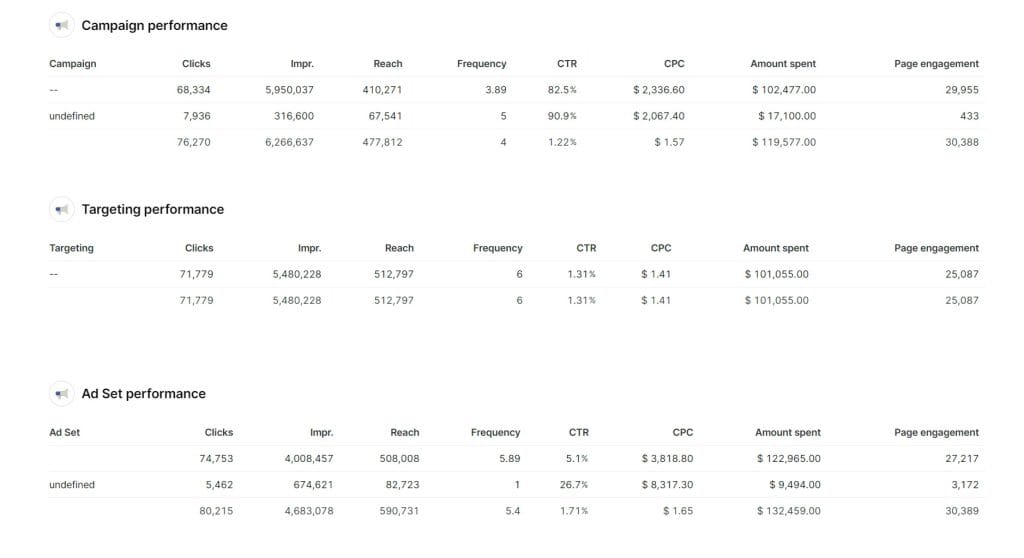
Fine-tuning Frequency for Engagement
- Monitor frequency to avoid overexposure, which can lead to diminishing returns or negative brand perception
- Use frequency caps to control individual ad exposure
- Balance frequency with reach to avoid repeatedly targeting the same small audience
Mastering Frequency Management
Experienced marketers know ideal frequency varies by campaign. Handle this complex metric with these strategies:
- Match Campaign Objectives:
- Brand Awareness: Often tolerates higher frequencies to build recognition
- Direct Response: Lower frequency with broader reach typically yields better results
- Adjust to Customer Journey Stages:
- New Prospects: Lower frequency, reach a wide audience
- Interested Prospects: Moderate frequency, nurture interest
- Near-Conversion: Higher frequency acceptable, focus on closing the sale
- Recognize Ad Fatigue Signs:
- Declining CTR
- Rising CPC
- Increased negative feedback (ad hides, reports)
- Apply Advanced Frequency Tactics:
- Modify bids based on exposure frequency
- Gradually lower bids as frequency increases
- Rotate creative to keep content fresh
Frequency Best Practices by Campaign Type
Adapt your frequency approach to different campaign goals:
| Campaign Type | Ideal Frequency Range | Key Considerations |
|---|---|---|
| Brand Awareness | 3-4 times per week | Prioritize reach, monitor brand recall metrics |
| Engagement | 2-3 times per week | Balance with engaging content, track sentiment |
| Conversion | 1-2 times per week | Focus on traffic quality, monitor conversion rates |
| Retargeting | 3-5 times per week | Higher frequency acceptable, but rotate creatives often |
Use these as starting points. Test and adjust based on your specific audience and campaign performance.
7. Impressions and Reach – Gauging Campaign Visibility
Impressions represent total ad displays, while reach measures unique users who’ve seen your ad. These metrics provide insight into campaign visibility and scale.
Importance in Our Metric Hierarchy
Impressions and reach offer foundational understanding of ad spread but rank lower for performance-driven agencies. They hold more relevance for brand awareness campaigns yet still contribute to overall campaign health assessment.
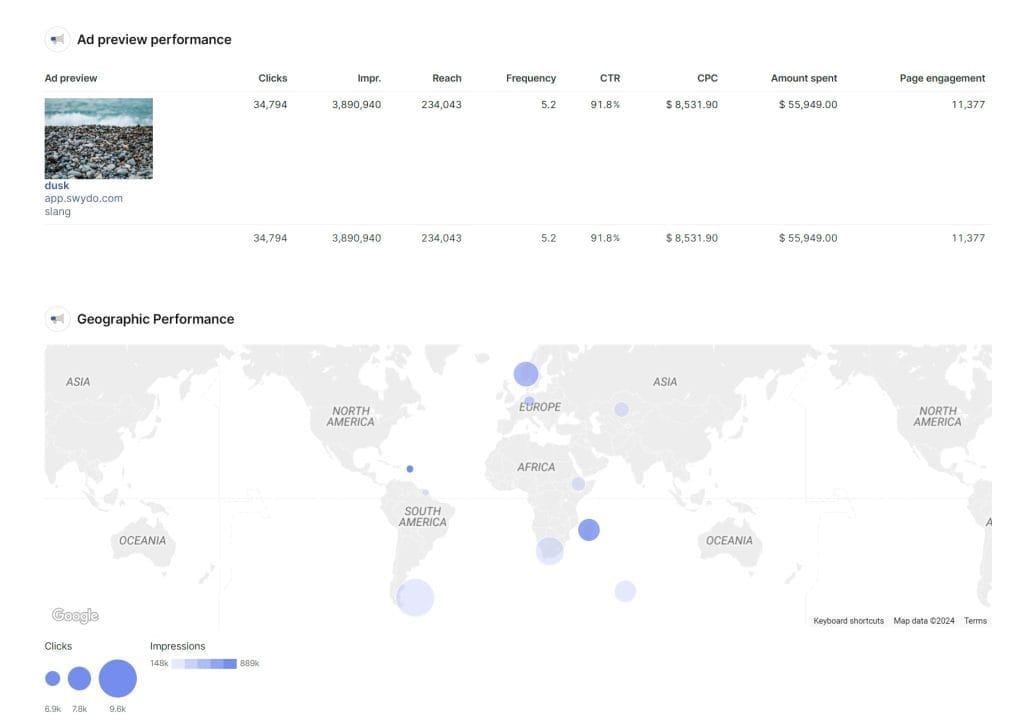
How to Maximize Impressions and Reach
- Assess audience size and identify expansion opportunities with reach data
- Compare impressions to reach to understand frequency (average views per user)
- Set reach goals for brand awareness campaigns to ensure broad audience connection
How to Balance Reach and Impact
Results-focused agencies must look beyond raw numbers:
- Quality Over Quantity: High reach doesn’t guarantee campaign success. Target the right audience, not just a large one.
- Impression-to-Conversion Path:
- Calculate average impressions needed for a conversion
- Use this data to set realistic campaign goals and budget allocations
- Reach and Ad Relevance Connection: Declining reach despite consistent spend might indicate dropping ad relevance scores. This can result from negative feedback or low engagement rates.
- Optimizing for Reach vs. Impressions:
- Brand Awareness: Prioritize Facebook reach to introduce your brand to maximum potential customers
- Retargeting or Conversion: Focus more on impressions to ensure repeated message exposure to a targeted audience
Reach-Frequency-Conversion Relationships
Understanding the interplay between reach, frequency, and conversion optimized campaigns:
| Scenario | Interpretation | Strategic Response |
|---|---|---|
| High Reach, Low Conversions | Potentially over-broad targeting | Refine audience targeting, enhance ad relevance |
| Low Reach, High Frequency | Possible audience saturation | Expand targeting, refresh creative |
| High Reach, Low Frequency | Message might lack stickiness | Increase frequency, improve ad memorability |
| Balanced Metrics | Campaign performance sweet spot | Maintain strategy, consider budget increase |
Pro Tip: Contextualize reach and impression reporting. Compare numbers to total target audience size to demonstrate market penetration. Link these metrics to broader business objectives to illustrate value beyond mere visibility.
These metrics are part of your mid-funnel metrics. While they’re important for understanding campaign visibility, remember to focus on more action-oriented metrics like Add-to-Cart and Cost per Add-to-Cart for a fuller picture of campaign performance.
8. Add-to-Cart Rate and Cost per Add – Mid-Funnel Performance Indicators
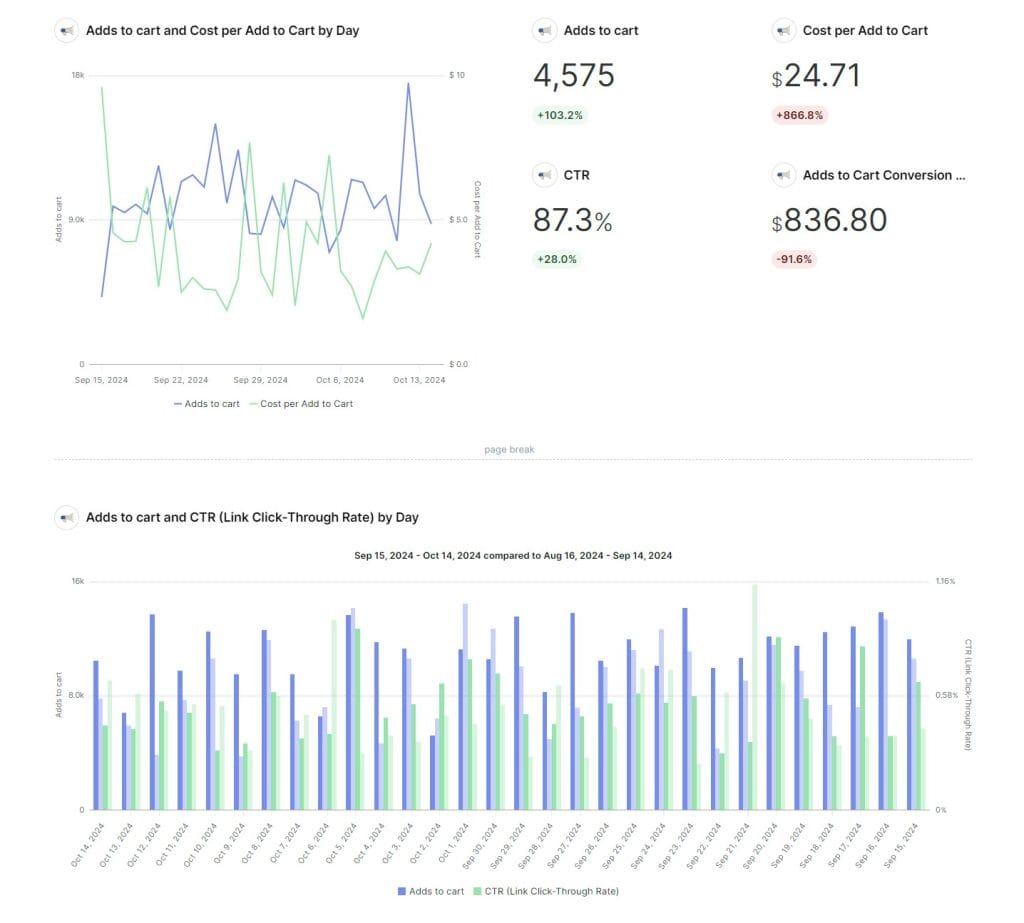
Add-to-Cart Rate and Cost per Add-to-Cart are mid-funnel metrics that offer crucial insights into user behavior and intent. These indicators reveal campaign performance beyond the initial click.
Why They’re Important
These metrics follow conversion rate in our priority list. They provide a more granular view of user interest and campaign efficiency, especially for e-commerce clients. A high Add-to-Cart Rate with a low Cost per Add-to-Cart indicates an effective campaign that’s generating strong product interest efficiently.
How to Calculate These Metrics
How to Use Improve Add-to-Cart Rate and Cost per Add-to-Cart
Several factors influence these two metrics, including product appeal, ad creative quality, landing page experience, and audience targeting accuracy.
To improve add-to-cart metrics, focus on refining product imagery and descriptions in ads, creating a seamless transition from ad to product page, and testing different ad formats like carousel ads for showcasing multiple products.
Audience segmentation based on past purchase behavior or interests can significantly boost performance.
For instance, a retargeting campaign focusing on users who’ve previously added items to cart but didn’t purchase might yield a higher Add-to-Cart Rate at a lower Cost per Add-to-Cart.
Relationship to Other Metrics
Understanding how these metrics interact with others can provide valuable insights:
- High Add-to-Cart Rate, Low Conversion Rate: Might indicate checkout process issues
- Low Add-to-Cart Rate, High CTR: Could suggest a mismatch between ad promise and product reality
- Cost per Add-to-Cart vs. CPA: Helps understand funnel efficiency by revealing where users drop off. Cost per Add-to-Cart measures interest (mid-funnel), while CPA tracks conversions (bottom-funnel), highlighting whether the issue is product interest or the checkout process.
Changes Over Time
Add-to-Cart Rate and Cost per Add-to-Cart typically evolve throughout a campaign’s lifecycle:
| Campaign Stage | Typical Behavior | Action Plan |
|---|---|---|
| Early Stage | Volatile as algorithm learns | Monitor closely, avoid major changes |
| Growth Phase | Should improve | Optimize targeting and creative |
| Mature Stage | Stabilizes | Watch for ad fatigue, refresh content if needed |
Pro Tip: Analyze the Add-to-Cart Rate by product type or category. This can reveal which products are most appealing to your audience, informing both your Facebook ad strategy and inventory decisions.
9. Video Completion Rate – Measuring Content Engagement
When running video ads on Facebook, it’s crucial to understand how well your content engages viewers. While Facebook doesn’t have a single metric called “Video Completion Rate,” it offers a range of metrics that provide valuable insights into how much of your videos people are watching.
Why VCR Is Important
Knowing how much of your video people watch helps you assess its effectiveness. High viewership percentages suggest your content is captivating and resonates with your audience. This is particularly important for brand awareness and storytelling campaigns, where conveying the complete message is key.
DeFazio points out an important distinction between video metrics that many advertisers confuse:
ThruPlays are ‘the number of times your video is played to completion, or for at least 15 seconds,’ whereas Video Plays are the ‘number of times your video starts to play and is counted for each impression of a video and excludes replays’.
This distinction is crucial for accurate performance measurement.
How to Measure VCR on Facebook
Facebook offers several metrics that shed light on video completion:
- ThruPlays: This shows how many times your video was played to the very end (or for at least 15 seconds, whichever comes first).
- Video plays at X%: These metrics show how many times your video reached specific viewing percentages (e.g., 25%, 50%, 75%, 95%, 100%). This allows you to pinpoint where people drop off and identify areas for improvement in your video’s structure and content.
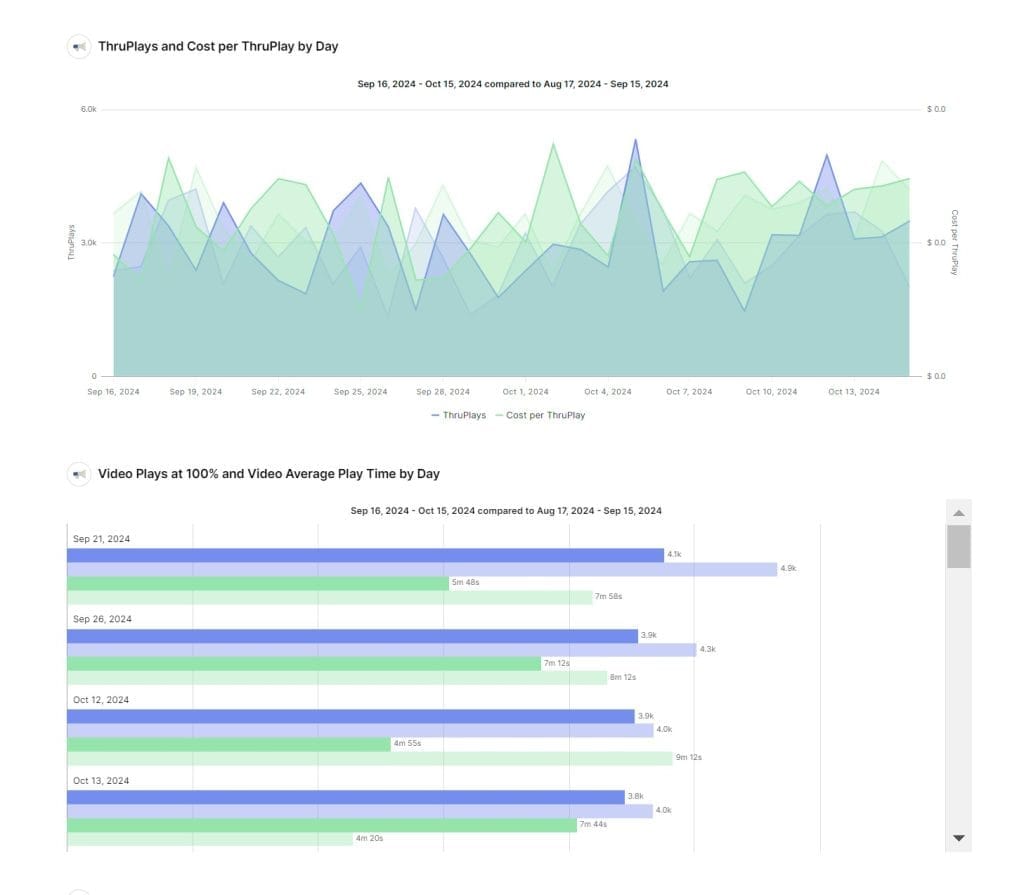
How to Improve VCR
To encourage people to watch more of your videos, consider these strategies:
- Front-load key information: Capture attention in the first few seconds.
- Use captions: Make your videos engaging even without sound.
- Create compelling thumbnails: Accurately represent your video’s content.
- A/B test video lengths: Find the sweet spot between conveying your message and keeping viewers hooked.
Relationship to Other Metrics
Analyzing video viewership metrics alongside other metrics (like click-through rate) provides a more complete picture of your video ad performance. For example, high ThruPlays but low clicks might suggest your video is engaging but lacks a strong call to action.
Changes Over Time
Expect video viewership metrics to fluctuate:
- Initial Launch: You might see higher viewership due to novelty.
- Mid-Campaign: Watch for declining numbers, potentially indicating audience fatigue.
- Long-Term: Use trends in video viewership to inform your future content strategies.
Pro Tip: Don’t just focus on ThruPlays. Pay close attention to the “Video plays at X%” metrics to understand how people engage with your video throughout its duration. This will help you identify specific areas for improvement.uration. This will help you identify specific areas for improvement.
10. Average Order Value (AOV) – Assessing Purchase Quality
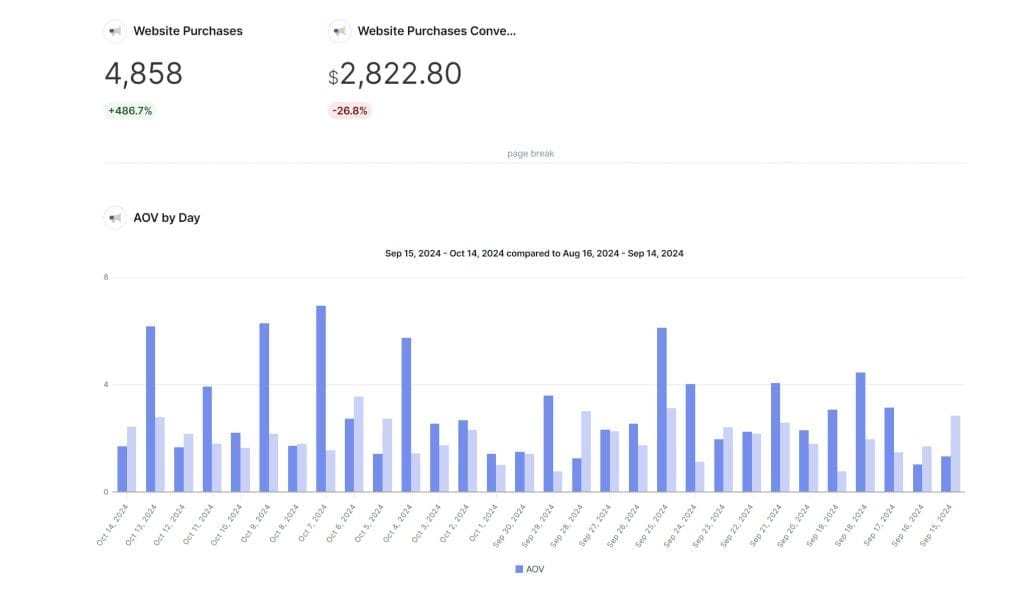
AOV is a critical metric for e-commerce campaigns. It measures the average amount spent per order and helps assess the quality of conversions, not just quantity.
Why AOV Is Important
AOV sits alongside ROAS and CPA in importance for e-commerce clients. It provides context to other metrics, helping determine the true value of your advertising efforts. A high AOV can justify higher acquisition costs and improve overall campaign profitability.
Calculating AOV
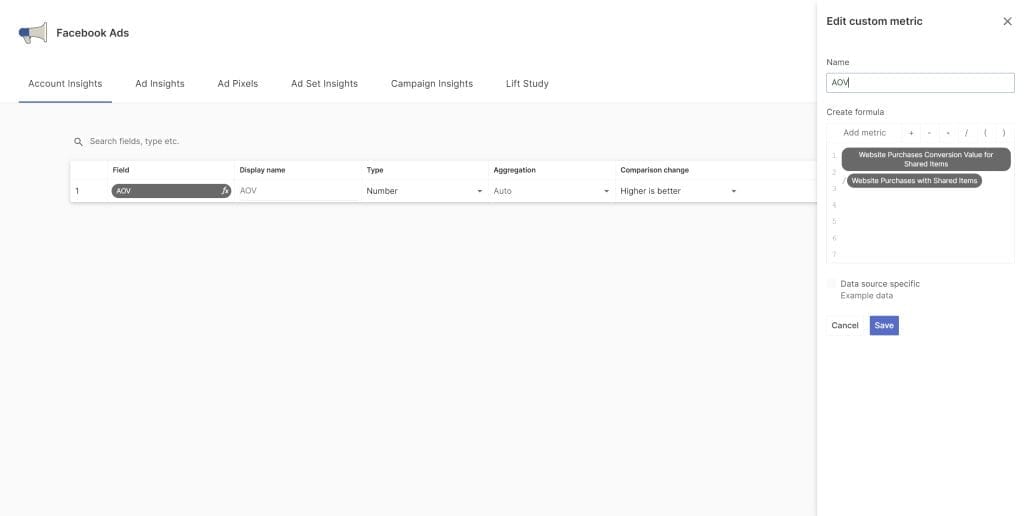
How to Improve AOV
Product pricing strategy, product mix in your ads, targeting, and seasonal trends all influence AOV. To increase it:
- Implement cross-sell and upsell tactics in your ads
- Create bundle offers or volume discounts
- Use dynamic ads to show complementary products
- Segment your audience based on past purchase value
- Offer free shipping thresholds to encourage larger orders
For instance, if you notice that customers who purchase Product A often also buy Product B, you could create bundle offers or use dynamic ads to suggest Product B to customers who’ve shown interest in Product A.
Relationship to Other Metrics
AOV often provides context to other key metrics:
- High AOV, High CPA: Might still result in profitable ROAS
- Low AOV, High Conversion Rate: Could indicate effective but perhaps overly broad targeting
- AOV vs. Customer Lifetime Value: Provides long-term perspective on customer worth
Changes Over Time
AOV typically evolves as follows:
- Early Stage: Might be lower as you attract first-time buyers
- Growth Phase: Look for increasing AOV as you refine targeting and offerings
- Mature Campaigns: Should show stable AOV with ongoing optimization efforts
Pro Tip: Analyze the relationship between AOV and customer lifetime value. Sometimes, customers who start with a lower AOV become more valuable over time. Consider the long-term perspective in your strategy, and use this insight to tailor your retargeting and loyalty campaigns.
How to use Facebook Ads KPIS for Different Campaign Goals
Campaign goals determine which metrics matter most. Each type of campaign needs specific measurements to show true success.
Akvile DeFazio emphasizes this point:
Even if you run an upper-funnel campaign, such as an engagement campaign, you should look at key performance metrics because conversions might still happen.
Engagement Campaigns
Engagement campaigns help you connect with your audience. The numbers that matter include:
- Post reactions, comments, and saves
- Shares and page likes
- Link clicks and their costs
- How often people interact with your content
These campaigns work well at the start of your marketing funnel, notes DeFazio. While you might not see immediate sales, these campaigns create awareness and familiarity that lead to future conversions.
App Install Campaigns
App install campaigns can drive both installations and in-app actions. DeFazio highlights that these campaigns go beyond basic installs – they can trigger registrations, trials, and purchases.
Key app metrics include:
- Mobile app installs
- Cost per install
- Trial starts and completions
- Registration numbers
- In-app purchase data
- Cost per specific app event
Lead Generation Campaigns
Lead generation offers two main paths, each needing different measurements. DeFazio shares a valuable observation: “Facebook’s native lead forms often get more leads at a lower cost. But website traffic campaigns that send users to landing page forms often bring in better leads. You’ll get fewer leads and pay more, but these leads show more interest because they took time to leave Facebook and learn more.”
Native Lead Forms Need These Numbers:
- Number of leads and cost for each
- How many people complete the form
- Signs of lead quality
Website Forms Need These Numbers:
- How many people view the landing page
- Form completion numbers
- Cost for qualified leads
- Time spent on your website
Video Campaigns
DeFazio points out that “Video campaigns show your product or service quickly and clearly, leaving less room for confusion and pushing people to act.” This makes videos great for showing products and telling brand stories.
Key Video Numbers:
- ThruPlays: DeFazio explains these as “videos played to the end or for at least 15 seconds” – different from basic video plays
- How much of the video people watch (25%, 50%, 75%, 95%, 100%)
- Cost for each ThruPlay
- Where people stop watching
Conversion Campaigns
Conversion campaigns focus on specific customer actions. DeFazio points out these essential metrics:
- Cost per conversion (CPA)
- Conversion rate (CVR)
- Conversion value
- Return on ad spend (ROAS)
The success of conversion campaigns depends on tracking both immediate results and long-term customer behavior. These metrics help prove campaign value and guide budget decisions.
Creating a Comprehensive View by Combining Metrics
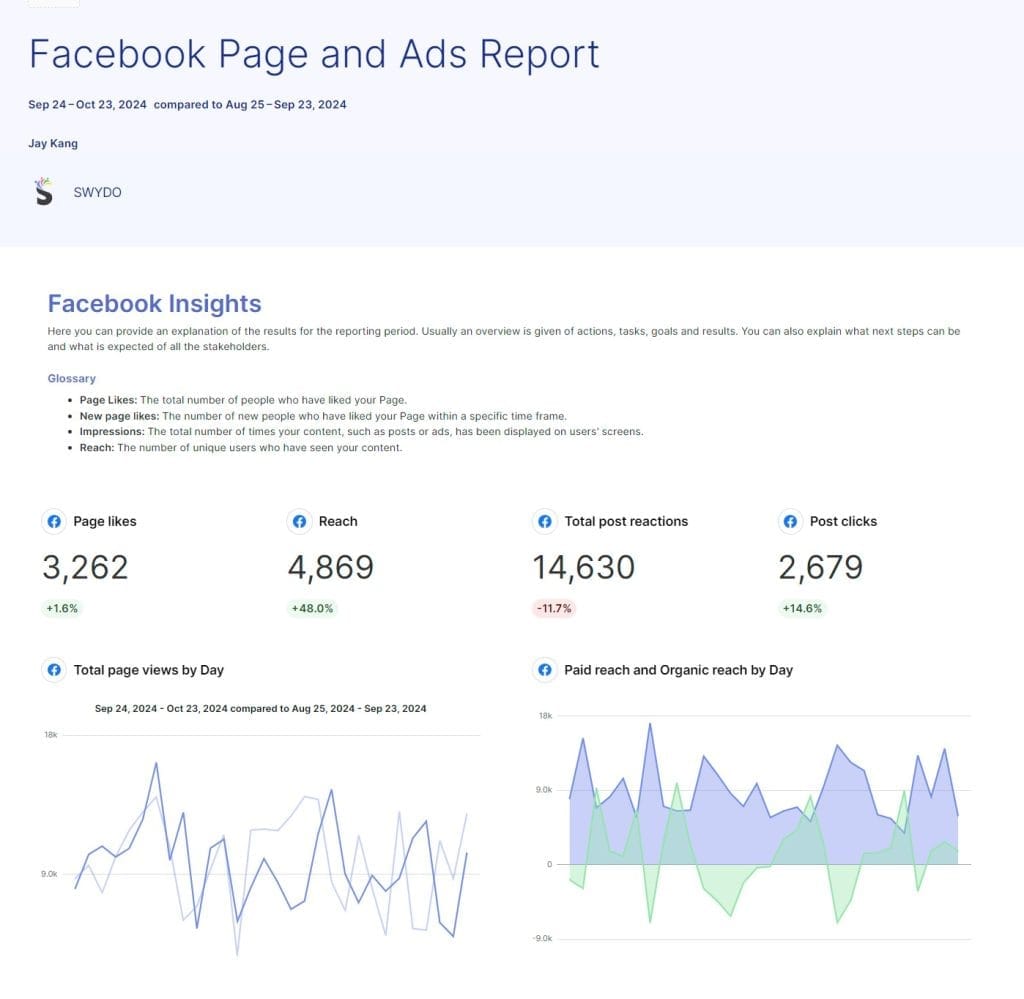
Agency professionals excel not just in understanding individual metrics, but in combining them to create a full picture of campaign performance. Here’s how to bring it all together:
1. Build an All-Encompassing Dashboard
Create a dashboard that displays key metrics side by side. This setup allows quick identification of patterns and anomalies. Include:
- Primary KPIs (ROAS, CPA, Conversion Rate)
- Supporting metrics (CPC, CTR, Frequency)
- Trend lines illustrating performance changes over time
2. Understand Metric Relationships
Grasp how different metrics influence each other. Examples:
- Rising CPC with stable CTR might indicate increased audience competition
- Improving CTR without a corresponding conversion rate increase could point to landing page issues
3. Factor in External Influences
Account for outside factors impacting your metrics:
- Industry-specific seasonal trends
- Competitor activities
- Sector-wide changes
- Facebook platform updates
4. Create a Compelling Narrative
Transform metric analysis into a compelling campaign performance story. This narrative should:
- Explain current performance trends
- Provide insights into causal factors
- Offer clear, data-driven recommendations for moving forward
5. Align with Client Objectives
Ensure metric analysis consistently ties back to primary client business objectives. Show how numbers translate to tangible business impact.
6. Track Date Created and Post Comments
The age of your ad (Date Created) can help identify potential ad fatigue. Regularly review older ads for performance drop-offs and refresh content as needed.
Post Comments provide qualitative feedback and indicate user engagement. Monitor comments for customer sentiment and potential product or service improvements.
7. Monitor Outbound Click-Through Rate (OCTR)
OCTR measures the percentage of people who click on links in your ad that take them off of Facebook. This is particularly important for campaigns aimed at driving traffic to your website or landing page.
A high OCTR suggests your ad is effectively encouraging users to leave Facebook and engage with your external content. If your OCTR is low, you might need to make your call-to-action more compelling or ensure your ad content aligns closely with users’ expectations.
Key Takeaways
Working with Facebook Ads requires agencies to go beyond campaign management. You function as a strategic partner, data interpreter, and growth catalyst for your clients.
Understanding these metrics, their interplay, and turning them into actionable insights will position you as a vital asset in your clients’ marketing strategies.
The Facebook/Meta Ads platform is always changing, but these core principles will always matter. Stay curious, never stop learning, and always look for ways to improve. This commitment to always learning delivers better results for clients and pushes the entire digital marketing field forward.
In Facebook Ads, data guides us, creativity sparks ideas, and strategic thinking gives us an edge.
Apply data analysis tools wisely to guide clients toward success in the shifting digital advertising landscape.
- Prioritize metrics based on direct client goal impact, emphasizing ROAS and CPA.
- Examine metrics in context and in relation to each other, not in isolation.
- Recognize natural metric changes throughout campaign lifecycles.
- Refine continuously based on data insights, avoiding knee-jerk reactions to short-term fluctuations.
- Convert complex metrics into clear, actionable client insights.
Get a clear picture of your Facebook Ads performance with Swydo’s automated reporting tool. Our intuitive tools help you understand what’s working and what’s not. Create insightful reports in minutes, track key metrics, and make better decisions. Try it free for 14 days – no credit card required.
